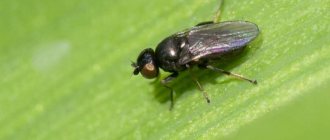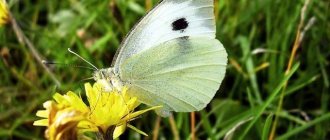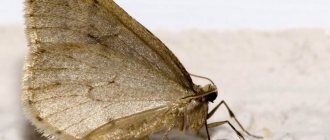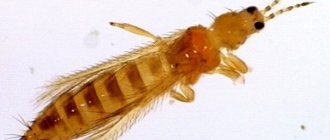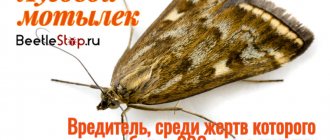Turnip white, or Pieris rapae, is popularly called turnip. This diurnal butterfly belongs to the white butterfly family from the superorder Amphiesmenoptera and is a very common and dangerous pest of cruciferous plants.
It is very common in Europe, the Caucasus and Transcaucasia, Kazakhstan and a large part of Asia. Found in Australia, North Africa and North America. In the Russian Federation, this species inhabits the entire European part, including Sakhalin and the Southern Kuril Islands, with the exception of the Far North.
Description of the insect
In appearance, reptiles are very similar to cabbage grass, or Pieris brassicae, but differ in size. A close species of the turnip white is represented by the rutabaga Pieris napi. The main difference is the absence of a dark green coating, which is characteristic of the lower segment of the veins of the hind wings.
Larva
The turnip white egg is pear-shaped and colored light yellow. The duration of embryonic development takes no more than 11 days and ends with the transition to the larval stage in the form of a caterpillar.
The pest larva is velvety green in color with characteristic light stripes and has 8 pairs of legs. The spiracles have a black border. The body length is 4 cm. Immediately after hatching, the caterpillars skeletonize the leaves, and then gnaw through passages of various sizes in the leaves or gnaw off the edges.
The development of the larva takes a month, during which five instars change and the molting process occurs four times. The caterpillars inhabit the upper surface of the leaf and are motionless during the day.
Pupation occurs on the surface of a solid object. The pupa is distinguished by the presence of sharp dorsal and lateral spines and is colored yellow-green with dark spots and three yellow stripes.
Most often, the color of the pupa depends on the substrate on which it is attached.
The summer generation of pupae develops in two weeks, and diapausing individuals remain for the winter.
Adult
The turnip white is capable of hatching from a summer pupa or after wintering. The adult butterfly has
The body length is up to 2.5 cm, and the wingspan is almost 5 cm. The turnip white, like all representatives of the Pieridae family, has club-shaped antennae, shortened labial palps, and bare eyes. It is characterized by a very developed proboscis and wide white wings with dark scales at the base. The ends of the front wings have a black crescent-shaped border. Males have forewings with a black tip and one blackish spot, while females have two such spots.
The first instar butterflies are found from April to May, the second instar from July to August, and the third instar from September to October. On the territory of the European part of Russia, the general flight periods are May - August. Pests of different ages have different forms of dark spots and differ in scaly cover.
Oral apparatus
Butterfly proboscis
In addition to color, butterflies have many other remarkable features. One of them is the oral apparatus, which is called sucking and is a proboscis, consisting of two modified, highly elongated lower jaws, capable of curling into a spiral like a clock spring. With the help of this “spring”, butterflies can feed only on liquid food: flower nectar, tree sap, sugary secretions of aphids.
Hawkmoth (Sphingidae)
The length of the proboscis depends on the flowers of which plants the butterflies visit. The longest proboscis is found in hawk moths (Sphingidae), large nocturnal butterflies with a thick body and long narrow wings. They are the best flyers among their fellow tribesmen, capable of hovering motionless, like hummingbirds, over flowers and getting nectar without sitting on them.
Clothes moth
There are species of butterflies in which the oral apparatus is generally underdeveloped, and they do not feed as adults. During their short life, such species use the reserves of nutrients accumulated by the caterpillar. Such, for example, is the well-known clothes moth, which lives in almost every home. It is the moth larva that damages woolen products, but the butterfly does not feed. By the way, only a few animals, including the moth caterpillar, are able to digest and assimilate wool as food.
Toothed moth
Another group of small butterflies, which is called toothed moths, has a gnawing mouthpart, inherited from their ancestors, and feeds not on liquid, but on solid food - plant pollen. The sensory organs of butterflies are no less unique. For example, only diurnal butterflies, distinguished by their bright colors, are able to distinguish the red color, which is inaccessible to other insects.
Interesting: Where do crayfish spend the winter?
Reproduction
There is pronounced sexual dimorphism and bisexual reproduction. The reproductive organs are located in the abdominal cavity. The female is much larger than the male. The reproductive organs of male reptiles consist of paired testes in tubes. This is where education happens.
sperm carrying the male component of genetic material to form future offspring. The sperm enters the genital opening, the location of which is the chitinized copulatory organ. At the moment of copulation, the fusion of gametes occurs.
The formation of eggs occurs in the oviducts of females, which are shaped like a rosary. As the eggs pass through the oviduct, they are enveloped in a special substance that is sticky. It is this property that allows eggs to attach to any surface. A female reptile can lay up to 500 eggs. Single laying is done on cruciferous plants.
Climatic conditions affect the number of generations. Under favorable conditions, their number can reach 5 in one season.
Life image
Reptiles are diurnal.
Prieš 1 metus
Of all Lepidoptera, they are the most resistant to cold.
This is confirmed by the fact that even in October they are energetic and can be seen everywhere, and already in March they again bring joy to people with their flights, announcing that the frost has ended and the warmth has come again. Reproduction of reptiles is bisexual. If the male flutters, making unusual movements, this means that mating time has come, and it is time to attract a partner to reproduce offspring. After mating comes the period to lay eggs.
Females can debug them one at a time. They stay on the leaf by gluing to the leaves or stems. And although all the eggs are located one at a time from one another, there can very often be up to 200 of them, but it happens that the number reaches 500.
These small eggs can be recognized by their shade of the palest yellow, fawn or shade of white. They are oval in shape, and more oblong at the edges. The development period is no more than a few days.
In May days, less often in June, caterpillars appear. Their body has no hairs, their body has a smooth structure. This stage lasts about a month. After this time, the caterpillar’s diet is not excessive: they eat only the leafy part of the plants, the most appetizing.
The development of the caterpillar takes about a month, and after this time it changes through five instars. Currently lives on the outer part of the leaves. If at this stage he senses any danger, he raises the front part of his body, but at the same time retracts his head. The threatening pose is complemented by a change in the color of the torso. A bright red color appears, plus the caterpillar can release a caustic liquid.
Large individuals feed by collecting nectar from a wide variety of plants.
Damage caused
The turnip moth is one of the most harmful butterflies that attacks cultivated and wild cruciferous plants. The greatest damage is caused by caterpillars, which first skeletonize the leaves and then can completely destroy all the leaves of garden crops. When a caterpillar gets inside a head of cabbage or lettuce, it becomes contaminated with the pest's excrement, which causes the plant to rot and die.
Cauliflower and cabbage are most often damaged. Pest attacks on plantings of turnips, rutabaga, radishes and other cruciferous vegetables may be observed. In the Leningrad and Moscow regions, turnip whitefish can develop in three generations. Turnip white caterpillars colonize plants before frost. Overwintering of reptile pupae most often occurs on weeds, hedges, and wall surfaces.
The pear flower beetle infects pears during the formation of ovaries, as a result of which the tree does not bear fruit at all. Do you know how to properly treat gooseberries against moths and aphids? If not, then this article will be useful for you.
Cutworm larvae are very dangerous insects as they infect many plants. How to protect yourself from these pests, read the link.
Disguise
Camouflage in butterflies
Many caterpillars are able to take the form of twigs, twigs, and dried buds. Some can copy snakes, and very successfully: they inflate the front part of the body, the spots on the sides resemble eyes, and the outgrowths near the head look like a forked tongue. Other caterpillars are completely covered with long, stiff hairs that break off easily and can cause irritation to the skin and respiratory tract. Instead of coloring and poisonous hairs, some caterpillars create a camouflage around themselves: they glue leaves together, build a web cover with twigs, pieces of bark, and straws woven into it, and spend their entire lives in this shelter.
Interesting: Why does a cat trample its paws? Reasons, photos and videos
Measures and means of control
Along with agrotechnical methods in the form of the destruction of cruciferous weeds, an effective method of control in a small area is the manual collection of caterpillars and their subsequent destruction.
It is recommended to promptly spray cabbage and other cruciferous crops with preparations that contain organophosphorus compounds, neonicotinoids and pyrethroids. Effective means are plant insecticides and biological pesticides.
Parasitoids for reptile larvae include Apanteles glomeratus and Hyposoter vulgaris, and for pupated pests - Pteromalus puparium.
Caterpillars
Apple codling moth
The main goal in the life of a caterpillar is food. They eat, as a rule, the green parts of plants, which are richest in nutrients. Others feed on fruits by sitting inside them, such as the well-known codling moth. And some have adapted to eat wood, wool and even wax.
Gypsy moth
Caterpillars eat a lot. Their body weight can increase 50,000 times. Since the caterpillar's body covers do not stretch well, the larvae molt several times during their lives, completely shedding their old skin. Some caterpillars can feed only on one specific type of plant, while others can feed on a wide variety of plant species, such as the gypsy moth or the American white butterfly, which are capable of eating the leaves of more than 300 species of trees and shrubs. Many caterpillars are able to secrete webs made of protein through their mouths. Some do this in huge quantities, weaving a cocoon from silk or coarser fibers - chesuchi. To obtain silk thread, people have been raising silkworm caterpillars since ancient times. The cocoon made by the caterpillar unwinds, resulting in a thin silk thread up to 1.5 km long.
Nowadays, butterflies are bred not only for silk. The population of many tropical countries lives by breeding the largest and brightly colored species for the manufacture of various crafts, paintings, panels of wings, and boxes of dried butterflies. The auction value of some rare specimens can reach several thousand dollars. But most of the butterflies sold continue to be caught in the wild, which, together with the constantly shrinking natural areas of their habitat, leads to a decrease in the number of these beautiful and often useful insects.
Interesting: What was the climate like during the time of the dinosaurs? Photo and video
General information about butterflies
It should be noted that these butterflies are the only insects that can be admired endlessly. These are amazingly gentle and fragile creatures. They are distinguished by a variety of colors and patterns, looking like unusual fluttering flowers. And what is most amazing is that an ordinary caterpillar can transform so much that it turns into such a charming creature.
Butterflies are one of the 34 orders of the Insect class. They belong to the kingdom Animalia and the phylum Arthropods. Their number is more than 350,000 species. Among them there are both daytime and nocturnal representatives.

